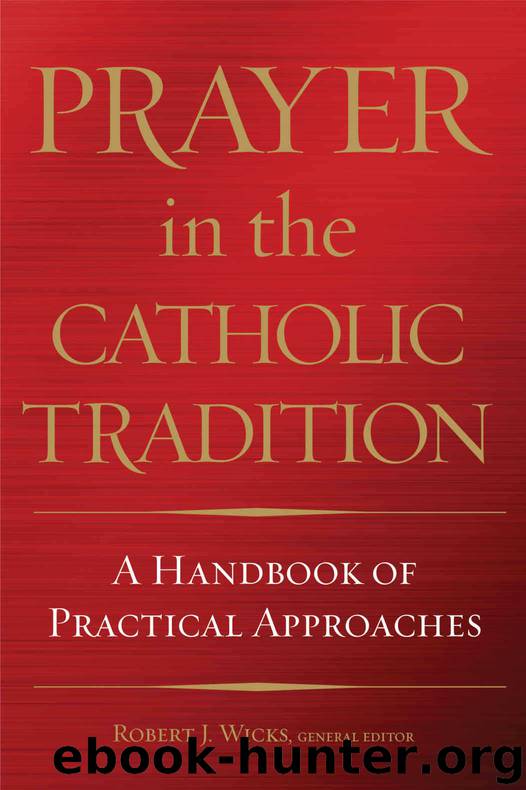Prayer in the Catholic Tradition: A Handbook of Practical Approaches by Robert Wicks

Author:Robert, Wicks [Robert, Wicks]
Language: eng
Format: epub
Publisher: Franciscan Media
Published: 2016-10-15T16:00:00+00:00
Chapter 19: Prayer in the Ignatian Tradition
~ Hung Trung Pham, SJ ~
Praying in the Ignatian tradition can be compared to falling in love. Neither of them pinpoints one specific moment or one simple experience, but they both reveal an ongoing process involving diverse and dynamic movements that embrace and embody all the moments and experiences of encounter between the lover and the beloved, including times of deep silence or even the seeming absence felt by one or the other. As in loving, praying does not confine itself to one particular practice, way, or method, but is open to all and is defined by all to the extent that all serve as means to creating a space of deeper freedom leading the person to an evermore intimate and loving encounter between the lover and the beloved. Thus, the ultimate goal of praying lies not in formulating one magical method, nor in searching for the correct acts and practices of devotion, nor in developing some perfect religious rituals and ceremonies, though all remain helpful and necessary. Ultimately, prayer orients, leads, and unites the individual person with the Divine.
Metaphorically, praying could also be compared to a courting dance where God—the lover—constantly and continually woos the person who prays—the beloved. Being madly in love, God attracts, inspires, and draws the individual to respond in love and freedom. Thus, while the lover who initiates the dance waits attentively, lovingly anticipates, and readily accompanies the beloved onto the next step of the dance, the beloved engages in prayer by remaining open and ready to be led by God—the lover. Thus, prayer does not end but continues progressing toward greater integration and deeper intimacy with the divine. Like dancing, the more frequently prayer is practiced, the more graceful and integrated its movement and rhythm become. The intimacy and the love shared between the lover and the beloved, radiating from each and every moment of the dance, illuminate the relationship in its beauty. Such a beauty in turn inspires, attracts, and draws others to join in the dance. Therefore, prayer proceeding from the individual naturally flows out to touch and to enliven the community.
The Method and Weeks of the Spiritual Exercises
Such emphasis on an intimate and interactive encounter with a personal God remains at the heart of prayer in Ignatian tradition. In fact, one of the preliminary notes that prefaces the Spiritual Exercises —one of the foundational texts of the Ignatian tradition—explicitly points out that these spiritual exercises facilitate the process of the Creator acting immediately with the creature, and the creature with its Creator and Lord.1 Consequently, such a personal and direct interaction and communication between God and the individual are emphasized throughout the Spiritual Exercises , thus in prayers in the Ignatian tradition. In fact, a colloquy is one of the most common forms of prayer, which the individual retreatant is often instructed to make. Accordingly, making a colloquy is understood to be “speaking as one friend speaks with another, or a servant with a master,
Download
This site does not store any files on its server. We only index and link to content provided by other sites. Please contact the content providers to delete copyright contents if any and email us, we'll remove relevant links or contents immediately.
Joan of Arc by Mary Gordon(4017)
Victory over the Darkness by Neil T. Anderson(2819)
The Gnostic Gospels by Pagels Elaine(2472)
Devil, The by Almond Philip C(2283)
The Nativity by Geza Vermes(2181)
The Psychedelic Gospels: The Secret History of Hallucinogens in Christianity by Jerry B. Brown(2122)
Going Clear: Scientology, Hollywood, and the Prison of Belief by Lawrence Wright(1940)
Going Clear by Lawrence Wright(1926)
A TIME TO KEEP SILENCE by Patrick Leigh Fermor(1865)
Barking to the Choir by Gregory Boyle(1786)
Old Testament History by John H. Sailhamer(1769)
Augustine: Conversions to Confessions by Robin Lane Fox(1737)
A History of the Franks by Gregory of Tours(1687)
A Prophet with Honor by William C. Martin(1685)
The Bible Doesn't Say That by Dr. Joel M. Hoffman(1652)
The Knights Templar by Sean Martin(1630)
by Christianity & Islam(1596)
The Source by James A. Michener(1540)
The Amish by Steven M. Nolt(1533)
